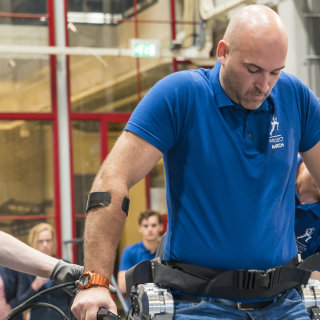On
Thursday 31 August, Project MARCH, a team of students from Delft University of Technology,
took the first steps with their new exoskeleton, the MARCH II. This is
the first student team in the Netherlands to achieve this. After a whole
year spent designing, developing and building, the students finally
revealed their assistive robotic system to the outside world. The
students hope that this new advance in medical technology will enable
paraplegics to resume their normal day-to-day activities.
During the
test day, Ruben de Sain (himself a paraplegic and team pilot), took the
first official steps towards the Cybathlon Experience, a version of the
Paralympic Games with bionic assistive devices. The students want to use
the event in Düsseldorf in early October to show that it is possible
for someone whose legs are paralysed to stand up from a deep sofa, walk
across an uneven surface or climb stairs.
The exoskeleton designed and built by the students in Project MARCH shows that paraplegics can walk
again. Using an exoskeleton has huge benefits for the user’s physical
and mental well-being. “Being able to walk is good for general mental
and physical fitness, and has a positive effect on the added
complications of paraplegia, such as cystitis and bowel problems,” says
Ilse van Nes, rehabilitation doctor at Sint Maartenskliniek hospital,
where Ruben de Sain underwent a rehab programme that used a commercial
exoskeleton.
“The fact that after 10 years, you
can stand up and talk to your family and friends at eye level is such
an amazing feeling“
For users, an exoskeleton is much more than a technological
device that ‘restores’ leg function. “The fact that after 10 years, you
can stand up and talk to your family and friends at eye level is such
an amazing feeling,” explains Ruben.
First steps
The
motivation for the 31 students from Delft University of Technology, who spent a year working on
this project on a voluntary basis, was simply the idea that they might be
able to restore full mobility to someone who had lost the use of their
legs. They started their design for a totally new user-friendly
exoskeleton a year ago. The design has been realised and they now have a
real exoskeleton to use for training purposes. After initial successful
training sessions, the student team has now managed to walk using their
exoskeleton. “We are delighted that it works, and I'm so proud of the
team and Ruben for everything we've accomplished so far. Now that the
first steps have become a reality, we can officially start the intensive
training programme for the Cybathlon Experience,” says Dingemanse, team
manager of Project MARCH. The team has until early October.
Cybathlon Experience
The Cybathlon Experience is a competition for bionic para-athletes, in which they use exoskeletons supplied by commercial and academic teams to complete the four elements of the event in the fastest time. The elements are designed to represent everyday situations. The first Cybathlon was held in Zurich in September 2016. This year's contest is part of the Rehacare event, an international trade fair revolving around rehabilitation, which takes place in Düsseldorf from 4 to 7 October.
”We hope that we can give an extra boost to the developments in this branch of medical technology”
“Alongside the competitive element, this competition is also an important opportunity for the teams to test the suitability of their exoskeletons in day-to-day situations and swap knowledge and experiences. We hope that together, we can give an extra boost to the developments in this branch of medical technology,” concludes Dingemanse.
